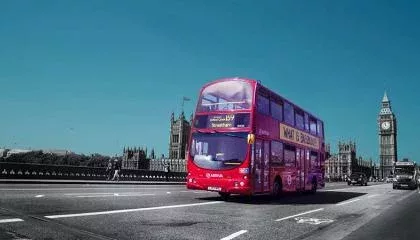University of Westminster research is promoting a greener London by making public transport safer and more appealing to commuters.
Any effort to making London public transport a preferred travel solution contributes directly to the greening of our capital. Greater use of public transport is essential to bringing London and the UK to net zero.
Innovations in CCTV (closed-circuit television) imaging, developed by Westminster researchers, is making London buses safer for all, helping this mode of sustainable transport play a key role in London’s journey towards net zero.
Professor Sophie Triantaphillidou, Professor John Jarvis and Dr Alexandra Psarrou of the Computational Vision and Imaging Technology (CVIT) research group, focus on optimising image and video quality, by investigating the interplay between visual perception, camera physics and image signal processing. Combining expertise in physics, engineering, computing, visual science and psychometrics, the Westminster team’s research is unique in its field.
Making CCTV effective
In 2009, the Metropolitan Police Service found that “for every 1,000 cameras in London, less than one crime is solved per year”. Despite an investment of £200m over 10 years, London CCTV had done little to fight crime.
Commissioned by the UK Home Office to fix this problem, Professor Triantaphillidou and her research team developed a new paradigm for optimising CCTV image quality for policing purposes. After establishing that facial identification was less effective in certain video compressions, the researchers formulated video compression limits suitable for different bus scenarios and conditions (lighting conditions, position of camera, standing or seated passengers). The research team also laid out a methodology for obtaining these standards.
Making London transport safer
The CCTV providers for London buses have traditionally had non-standardised quality settings. This made video recordings from buses vary hugely in image quality and hindered the use of CCTV videos in bringing perpetrators of crime to justice.
Working with the findings of Professor Triantaphillidou and her then PhD student Dr Anastasia Tsifouti, in 2014 Transport for London (TfL) enacted their recommendations and produced standardisation across all London buses’ CCTV recordings, for the first time ever.
The research team’s “findings were used to set minimum CCTV quality levels for the CCTV fitted to all new buses”, the Analytics Research and Data Outreach Manager at TfL, explains. “This was implemented through the ITT Bus Build Specification, which sets out the bus build standards for all new buses as part of the requirements for all bus route tenders. This is mandatory”.
By April 2020, TfL had fitted approximately 9,000 buses in the fleet with CCTV cameras that follow these specifications.
The new standards mean human faces can now be consistently, successfully, identified from London bus CCTV footage, making it a vital tool in crime investigation for the first time.
Good CCTV significantly increases the chances of detection. Bus CCTV is currently recognised as some of the best quality CCTV covering the public domain, which is one reason why the request for it continues to rise annually.– The Analytics Research and Data Outreach Manager at Transport for London
The usefulness of such enhanced CCTV imagery is demonstrated by the year upon year growth in requests for access to London bus CCTV footage by the Metropolitan Police Service in their investigations, between 2016 and 2019.
Several high-profile prosecutions have successfully employed such CCTV recordings as evidence, discouraging perpetrators of potential crime, and building confidence amongst the public that they can travel safety on London buses.
Expanded benefits: enhancing camera phone technology
Across a four-year project funded by the UK’s Ministry of Defence, Professor Triantaphillidou and the CVIT research group developed an experimental method for measuring the visual perception of forms, shapes and details from digital images, rather than traditional test charts. The results improved on past models, providing a better reflection of the complex workings of human vision when viewing any sort of imagery.
This work, in turn, led to the improved design of imaging products and solutions in the commercial sector.
Building on the above insights, and in collaboration with engineers at Huawei Technologies Co Ltd, China, Triantaphillidou and her Westminster team proposed and implemented a successful verification methodology that connected image quality predictions with customer experience ratings.
This has led to enhancements in the research and development workflow of the smartphone company and related efficiency savings. Further, this work, which robustly predicts customer satisfaction with Huawei’s phone camera image quality, is of key significance for Huawei’s commercial strategy in this area. The brand increased its market share by 66% in 2019, a growth, The Vergeargues, boosted by its phone camera technology: “The company has invested heavily in its camera hardware, which has paid off with terrific performance (currently unmatched in low light) and has stirred smartphone owners to hit the ‘upgrade’ button”.
Huawei is not the only company potentially benefitting from this innovative research. After working on TfL’s CCTV enhancement as part of Triantaphillidou’s team, Dr Anastasia Tsifouti, a former Westminster graduate and Home Office Scientific Development Branch employee, joined Spectral Edge in 2018. A tech start-up specialising in improving picture and video quality, Spectral Edge drew directly from the TfL project’s methodologies and data, which featured in a 2019 white paper it produced. Apple acquired the SME in 2019, with Bloomberg suggesting its technology could enhance Apple’s camera AI “by continuing to improve the quality of photos in low-light environments”.






















